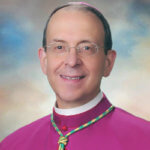Introduction
It is moving beyond words to be here at the Martyrs’ Altar, above which stands the replica of Tyburn Tree, and to celebrate here the Holy Mass, which was at the center of the lives of the martyrs who gave their lives at Tyburn, just some 200 yards from where we are right now.
Salvete, Flores Martyrum
The sixteenth century, during which the martyrdoms at Tyburn took place, was truly a of “golden age” of heroism and saintliness in the history of the Church. The stories are still told, with great reverence of the scores of young men from these shores, brimming with life, energy, generosity, and faith, who trained for the priesthood in Rome and elsewhere in Europe, knowing full well that upon their return to this, their native land, they faced a very likely and violent martyrdom. How many of them, when they were still seminarians, must have looked upon images of Our Lord on the Cross, while in the back of their minds suspecting that, for them, the Cross would one day take the form of the triple gallows of Tyburn Tree.
How moving must have been the scene, so often repeated, when the newly ordained priests from the Venerable English College in Rome were seen off from the Eternal City on their journey back here to England by no less a personage than St. Philip Neri himself, who, with tears streaming down his face, would bid them farewell while chanting the hymn “Salvete, flores martyrum,” which is traditionally sung at Lauds (or Morning Prayer) on the feast of the Holy Innocents.
We think of the heroes of the Faith who met their martyrdom here, and opened their eyes from here to the glory of Heaven. As an archbishop, I naturally think (not without some trepidation) of the very last of the martyrs at Tyburn, Saint Oliver Plunkett, Archbishop of Armagh, who was led to Tyburn Tree in his pontifical robes.
We call to mind the names of real heroes such as Saint John Roberts, Saint Margaret Ward, Saint John Houghton. And yet I cannot think of Tyburn without thinking of the moment of the conversion of Saint Henry Walpole at the martyrdom of Saint Edmund Campion, some 433 years ago this week. I referenced the story yesterday at the Campion Day Mass at Stonyhurst, but it certainly bears a mention here – a mention of the moment, so full of darkness but so full of light, during which, as the executioner dismembered the body of St. Edmund, a drop of his blood splashed onto the young bystander, Henry Walpole. So great was the effect of that martyrdom, and of God’s grace, in the soul of Henry Walpole, that thereafter he too became a Catholic, a priest, a martyr, and a Saint. Indeed, as Tertullian said in the first Christian centuries, “The blood of the martyrs is the seed of the Church.”
It is Better to Take Refuge in the Lord
The brave and faithful men and women who were martyred here for their faith in Christ, and their allegiance to His Church, certainly exemplified the words of the psalmist which we heard today: “It is better to take refuge in the Lord than to trust in man. It is better to take refuge in the Lord than to trust in princes.”
Dear friends, in this very convent, there is always at least one nun praying before Our Lord in the Most Blessed Sacrament. We know that these prayers obtain great graces for the world.
And my prayer, in this Mass, is specifically this: that the blood of the martyrs at Tyburn so long ago, together with the prayers of the nuns even today, will obtain for England, and for Baltimore, and for the Church throughout the world, the grace of new priestly vocations: young men rich with gifts of life, of energy, of generosity, and of faith, who in our time will trust not in princes, but in the Lord, and who, with gifts of nature and grace, will be able to carry forward the mission of the Church, and the proclamation of the Gospel, and the celebration of the sacraments, come what may – come rack, come rope – for the glory of God, and for the salvation of souls. Amen.

